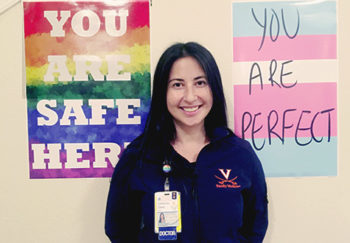Imagine you go to the doctor. You’ve gone to this clinic for years. The nurse who weighs you is, as always, friendly. She’s got your chart in her hands. She asks about your kids. And then: “How’s your husband?”
But you don’t have a husband. You could be a widow, divorced, or just single. So the question causes discomfort. You could be gay, and beyond feeling annoyed and awkward, you feel other layers of emotion.
Because you’re gay, you may have been shamed, judged, rejected, or even estranged from family members. Maybe you’ve heard you’re unnatural and abnormal, and that who you are hurts other people.
Second-Guessing Yourself at a Clinic Visit
Having to clarify that you’re gay can be a distressing situation. Should you even correct her? What if she treats you weird? But also: Why does it matter? And who cares?
In that moment, to feel so exposed and vulnerable it doesn’t feel worth it to contradict the nurse and later feel even more shame for being a coward and not speaking up.
That’s when you decide never to go back to the clinic again.
Doctor Avoidance = LGBTQ+ Face More Health Risks
According to the Agency for Healthcare Research and Quality, members of the LGBTQ+ community are at higher risk for certain mental and physical health conditions. Therefore, individuals may avoid going to the doctor for check-ups that would find cervical cancer, heart disease, intestinal problems, and the like.
In a report by a White House committee on LGBTQ+ equity, it’s outlined that the LGBTQ+ community experiences substantial discrimination throughout the U.S. healthcare system. The harmful impacts can last for years.
How to Deliver LGBTQ+ Friendly Healthcare
Gynecologist Dana Redick, MD, is one of many providers at UVA Health implementing best practices of inclusive care in her clinic.
She shares key things her clinic, and others, can do to provide an inclusive environment.
Know Your Patient’s Community
Redick says it’s important to understand the unique things about any marginalized community. Familiar with myths that circulate in the gay community, Redick can give her patients the healthcare information they might not get elsewhere.
“People not needing contraception may go a long time without gynecologic care. For women who have sex only with women, many falsely believe they are not at risk for sexually transmitted infection and/or they do NOT need pap smears,” Redick says. “Many patients with a uterus and cervix don't want to come in for a pelvic exam, but they still need HPV testing as screening for cervical cancer.
She adds, “They’re also at higher risk of non-sexually transmitted infections like bacterial vaginosis. Though not life threatening, these can impact a person’s quality of life.”
Have a Welcoming First Impression
The Midlife Health and Gynecologic Specialties Northridge clinic where Redick practices displays rainbow flags and safe space stickers. This very clear messaging communicates the clinic's intention to offer LGBTQ+ friendly healthcare.
Other materials can also communicate welcome. Photos of patients and doctors that include people from all backgrounds and walks of life. When you see a poster in a waiting room with people who look like you, it reinforces that you’re in a welcoming place.
Train & Educate Staff
Creating a warm, welcoming environment means infusing empathy and understanding into every interaction. “I try to teach my staff and students about the trust and vulnerability that goes into taking care of people,” she says. “In particular, patient populations who’ve had discrimination — you have to recognize that when you care for them.”
This approach extends beyond her clinic. Making patients feel at home with her isn’t the whole story. “We typically screen all patients for smoking, alcohol, intimate partner violence, prior sexual abuse, body image problems, and weight concerns,” Redick explains.
“But these topics can be especially hard for LGBTQ+ patients to talk about and find welcoming resources to help manage.” LGBTQ+ friendly healthcare means screening for issues without stigmatizing and generalizing people.
So, Redick coaches her teams and medical students to help patients when they need other specialists. “We know the healthcare system, so we can help people navigate it.” On top of that, “We can help them be advocates for themselves.”
Make It Easier to Come Out
At UVA Health, patients can use the online tool, MyChart, to see test results, make appointments, ask questions, pay bills, and more. The most recent update allows patients to designate a preferred name, list their pronouns, and add a photo.
This change empowers transgender patients to own their identity throughout the health system. This can make things easier and smoother when you register for your appointment, check in at the clinic, and talk to nurses.
Redick has seen how hard it is for patients to share their sexual orientation. “The concept of coming out as a patient shows an incredible amount of trust in you and you need to honor that,” she says.
The MyChart update helps patients come out in a way that feels less confrontational and personal. Redick notes she’s already had patients use MyChart to identify their sexual orientation who hadn’t come out to her before this update.
Looking for support?
Your healthcare matters.
We All Benefit from Inclusion
By making things better for one group, Redick says, usually benefits everyone. “Preferred names in MyChart has been a bonus for everyone,” she explains. It isn’t just those in the LGBTQ+ community who use names different than what’s on their birth certificate.
Redick cites the example of buildings made handicapped accessible. “It was done for patients in wheelchairs, but suddenly moms with baby strollers could get into the building easier.”
That is, all of Redick’s efforts to understand and care for her LGBTQ+ patients exist as part of her larger approach to treating each patient as an individual.
Inclusion doesn’t just serve one group or one type of patient. “Good care is good care for lots of people,” she says. Knowing patients “beyond their diagnosis is good for everybody.”



Thank you for publishing this important post about the LGBTQ+ patient population!